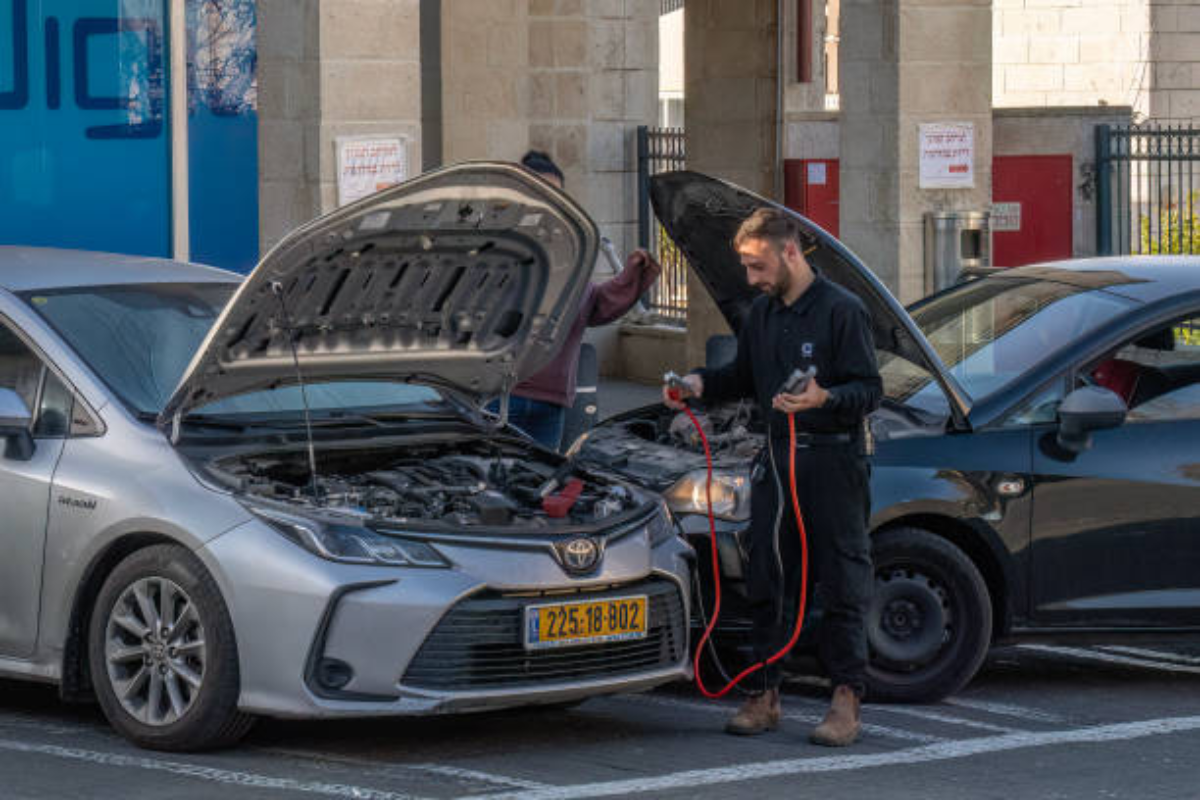Car batteries can die at the worst times—when you’re late for work, parked in a quiet lot, or in cold weather. Knowing how to jumpstart a car is an essential life skill that helps you get moving again without calling a tow truck. This guide explains the process in simple steps, using clear language anyone can understand. Whether you’re helping a friend or dealing with your own vehicle, this article will prepare you to handle a dead battery calmly and safely.
What You Need Before You Start?
Tools Required to Jumpstart a Car
To jumpstart a car, you need a few simple items. The most important are jumper cables and a second vehicle with a working battery. Make sure the cables are long enough to connect both car batteries. If you’re using a portable jump starter instead of another car, keep it charged and ready in your trunk. Some models even come with built-in safety features that help prevent connection mistakes.
Safety Precautions to Keep in Mind
Safety is very important. First, check the batteries for visible damage. Do not attempt a jumpstart if you see leaks or cracks. Turn off both cars before connecting cables. Make sure metal objects like tools or jewelry don’t come into contact with the battery. Always follow the correct order for connecting and disconnecting the cables—this prevents sparks or shocks. Keep your face and body away from the battery while working.
Understanding How a Car Battery Works
Why Car Batteries Die?
Car batteries can stop working for many reasons. Sometimes it’s because lights were left on overnight. In cold weather, the battery struggles to hold power. If the car hasn’t been driven for a while, the battery may slowly drain. Also, older batteries naturally lose their strength over time and need replacement after a few years.
Signs Your Battery Needs a Jump
If you try to start your car and only hear clicking or nothing at all, your battery might be dead. Dim headlights, slow cranking, or a dashboard warning light are other clues. In these cases, jumpstarting may help you get back on the road—but it’s a temporary fix if the battery is very old or damaged.
Step-by-Step Instructions on How to Jumpstart a Car
Positioning the Vehicles
Start by placing both cars close enough for the jumper cables to reach—usually hood to hood works best. Make sure the two vehicles are not touching. Turn off both engines and set the parking brakes. Open the hoods and locate the batteries.
Connecting the Jumper Cables Correctly
First, connect the red cable to the positive (+) terminal on the dead battery. Then, attach the other end of the red cable to the positive terminal of the working battery. Next, connect the black cable to the negative (–) terminal on the working battery. Finally, attach the other end of the black cable to an unpainted metal surface on the dead car’s engine block. Do not connect it directly to the negative terminal of the dead battery—it can cause sparks.
Starting the Dead Car Safely
Once all connections are in place, start the car with the working battery. Let it run for a few minutes. Then, try to start the dead car. If it turns on, let both cars run for a few minutes to transfer charge. If it doesn’t start, wait a little longer before trying again.
Disconnecting the Cables in Proper Order
Once the dead car is running, remove the cables in reverse order: black from the grounded metal, black from the working battery, red from the working battery, and finally red from the previously dead battery. Be careful not to let the clamps touch each other or any metal surface during this process.
What to Do After Jumpstarting Your Car?
Letting the Engine Run
After your car starts, let it run for at least 15–30 minutes. This allows the alternator to recharge the battery. Keep an eye on warning lights during this time—if anything seems unusual, your battery or alternator may need professional attention.
When to Drive and How Far?
If the car runs smoothly, take it for a drive. A 20–30 minute drive at highway speeds is ideal. This gives the battery enough time to regain its charge. Avoid short trips right after a jumpstart because they don’t give the battery enough time to recover.
Common Mistakes to Avoid During a Jumpstart
Many people make errors that can be dangerous. The most common mistake is connecting the cables in the wrong order. This can damage electrical systems or cause sparks. Another mistake is jumpstarting a leaking or swollen battery—it’s not safe. Also, never let the vehicles touch during the process. Using poor-quality cables or skipping the grounding step are also risky. Always take your time, follow the steps, and prioritize safety.
How to Jumpstart a Car Without Another Car?
Using a Portable Jump Starter
If there’s no second car available, a portable jump starter can be a lifesaver. These small battery packs are easy to use. Connect the clamps to your battery, turn on the pack, and start the engine. They’re safe and effective when used correctly. Always keep the device charged and read the instructions before use.
Is Push Starting an Option?
For manual transmission cars, push starting is sometimes possible. This method involves rolling the car while it’s in gear and popping the clutch to start the engine. However, it requires help and isn’t always reliable. It also doesn’t work with automatic transmission vehicles.
When to Replace the Battery Instead of Jumpstarting?
If your car won’t stay running after a jump, the battery may be too old or damaged. Most batteries last 3 to 5 years. If you’ve needed multiple jumpstarts recently, it’s probably time for a replacement. Look for signs like slow starts, dim lights, or corrosion around the terminals. Getting a new battery is safer and more reliable than relying on jumpstarts.
Conclusion
Learning how to jumpstart a car is one of those basic skills that can save time, stress, and money. Whether you’re using jumper cables or a portable starter, the key is to stay calm and follow each step safely. Keep a set of tools in your trunk, understand your battery’s condition, and don’t hesitate to replace it when needed. With this knowledge, you’re better prepared for unexpected situations and can help yourself—or someone else—get back on the road with confidence.
FAQs
1. How long should I leave jumper cables connected?
Leave them connected for a few minutes while the working car is running. Once the dead car starts, wait another 2–3 minutes before disconnecting.
2. Can I jumpstart a car with a completely dead battery?
If the battery is very old or fully drained, it might not respond. You may need a new battery if the car won’t start after several tries.
3. What happens if I connect the cables incorrectly?
Incorrect connections can damage the car’s electrical system or cause sparks. Always double-check the cable placement before turning anything on.
4. How often can I safely jumpstart my car?
Occasional jumpstarts are fine, but frequent ones suggest a deeper issue with your battery or alternator. Have the system checked by a mechanic if it happens often.
My name is Mustafa, and I have been blogging for over 5 years. I am passionate about sharing complete, accurate, and helpful information with my readers. Along with managing content on The Matcha Read, I also contribute blog posts to premium websites. My goal is to provide valuable insights in a clear and easy-to-understand way, so every reader walks away with useful knowledge.










